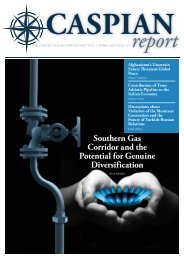Create successful ePaper yourself
Turn your PDF publications into a flip-book with our unique Google optimized e-Paper software.
FATIH MACIT, HOLLY REHM<br />
14<br />
these two states was the fastest in<br />
the country during this period. 27<br />
The economic effects of the shale oil<br />
and gas boom have been especially<br />
striking in North Dakota. In 2002,<br />
North Dakota had the second smallest<br />
economy in the country with<br />
economic output of just $24.7 billion<br />
a year. In the ten years since, North<br />
Dakota has doubled its economy to<br />
$49.4 billion a year. This massive increase<br />
in economic output was driven<br />
primarily by the oil and gas boom<br />
in the Bakken shale play. 28 The state’s<br />
GDP growth of 9.7 percent was the<br />
country’s fastest in 2013, while its<br />
unemployment rate of 2.9 percent<br />
was the lowest nationally. North Dakota’s<br />
one-year population growth<br />
of 3.1 percent is also the highest in<br />
the country, as people flock to the<br />
state to fill the jobs mainly created<br />
by the oil and gas sector. In fact, the<br />
economic growth of the five fastest<br />
growing states in 2013—including<br />
Wyoming, Oklahoma, and West Virginia—was<br />
primarily the result of oil,<br />
gas, and coal production. 29<br />
Though shale gas production actually<br />
fell in 2013, most experts predict that<br />
U.S. shale production will continue to<br />
grow in the future. The IEA estimates<br />
natural gas output in the U.S. will increase<br />
from an estimated 650 bcm<br />
in 2011 to 840 bcm in 2035. This<br />
projection puts the U.S. ahead of Russia<br />
as the largest gas producer, and<br />
ahead of Saudi Arabia as the largest<br />
hydrocarbon producer in the world. 30<br />
This increase is due almost exclusively<br />
to shale gas sources. The EIA estimates<br />
that shale gas production will<br />
grow from 7.8 trillion cubic feet (tcf)<br />
in 2011 to 16.7 tcf in 2040. The EIA<br />
also projects that the share of shale<br />
gas in total U.S. gas production will<br />
increase from 40 percent in 2012 to<br />
53 percent in 2040. 31 By comparison,<br />
27.<br />
Stephen P.A. Brown and Mine K. Yücel (2013), “The Shale Gas and Tight Oil Boom: U.S. States’<br />
Economic Gains and Vulnerabilities,” New York, New York, 2-3.<br />
28.<br />
Blake Ellis, “How North Dakota’s economy doubled in 11 years,” http://money.cnn.<br />
com/<strong>2014</strong>/06/11/news/economy/north-dakota-economy/. Accessed June 17, <strong>2014</strong>.<br />
29.<br />
Alexander E.M. Hess and Thomas C. Frohlich, “10 states with the fastest growing economies,”<br />
http://www.usatoday.com/story/money/business/<strong>2014</strong>/06/14/states-fastest-growingeconomies-new/10377735/.<br />
Accessed June 17, <strong>2014</strong>.<br />
30.<br />
IEA (2013), “World Energy Outlook 2013,” Paris, France, 1<strong>08</strong>-109.<br />
31.<br />
EIA (<strong>2014</strong>), “Annual Energy Outlook <strong>2014</strong>,” Washington, DC, MT-23.










